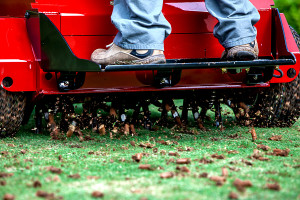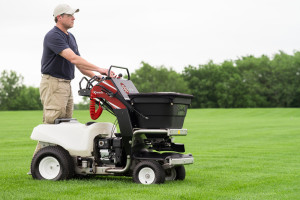Regardless of where you live and what type of turf grass you’re working with, aeration can help your lawn be healthier and more beautiful. The trick is knowing when it’s best to aerate, what equipment to use, and what else you can do to encourage the vigor of your grasses, while limiting weeds’ ability to gain a foothold in the lawn.

Core aeration can be beneficial for most lawns if performed at the right time for the type of turf grass you’re working with.
According to Josh Friell, Ph. D, of The Toro Company’s Center for Advanced Turf Technology, aeration introduces temporary stress to the turf, and recovery time is closely linked to growing conditions and annual growth cycles. As a result, it’s important to keep those considerations in mind when determining an annual aerification plan.
When is the Best Time to Aerate?
Aeration is best performed just before or during periods of high growth, but not immediately preceding or during periods of stress to the lawn, whether from heat or drought. The type of grasses that make up your lawn will determine the best time of year to aerate.
If you’re working with cool season grasses, including bluegrass, creeping bent grass, fescue and ryegrass, it’s best to aerate during the growth periods in the spring and fall.
In the spring, wait until you’ve mowed the lawn a few times before aerating. This will ensure the lawn is growing fast enough to recover and take advantage of the increased pore space and air exchange at the root zone that aeration creates.

It’s a good idea to apply fertilizer and weed killer just after aeration to minimize the opportunity for weeds to take advantage of the short-term turf stress from aeration.
One caveat, says Friell, is that any disturbance of the root zone in the spring can increase weed competition by bringing buried seeds to the surface.
“You can reduce the potential for weed competition and increase the hardiness of the grasses by applying fertilizer and a pre-emergent weed killer following aeration. But don’t apply a weed killer if you plan to overseed following aeration, as it will prevent germination of the seed you put down.”
For warm season grasses such as Bermuda grass, buffalo grass, St. Augustine and zoysia grass, aeration can take place during warm times of the year between late-spring and early-autumn.
“Aeration should be performed early enough in the fall that the turf can recover before it needs to prepare for winter dormancy,” Friell said.
As for frequency, Friell said aeration should be performed at least once per year on most lawns, while twice annually is best for lawns with compacted soil, or soil with high clay content.
What To Do Before or After Aeration
Watering after aeration is always a good idea, as Friell said aeration should never be performed when turf is wet, or the dirt contains enough moisture to be muddy.
As mentioned earlier, the application of fertilizer and weed killer is beneficial shortly following aeration, but be sure to skip the weed killer if you’re going to overseed following aeration.
Friell said overseeding following aeration makes sense because seeds can take advantage of the disturbed surface to create better seed-to-soil contact.
“Better seed-to-soil contact means better conditions for successful germination.”
Learn More:
- Exmark Aerators
- “When to Aerate Your Lawn“, Bayer Advanced, Web. Accessed Jan. 28, 2016
- Day, Julie, “Spring Lawn Care Guide“, TodaysHomeowner.com, Web. Accessed Jan. 28, 2016
- Fresenburg, Brad S. “Spring Lawn Care — Aeration, Fertility and Crabgrass Control“, University of Missouri Integrated Pest Management, Web. March 15, 2012
- Juror, Richard and Wallace, Greg, “Properly Aerating Lawns“, Iowa State University Extension and Outreach, Web. Aug. 12, 2015






